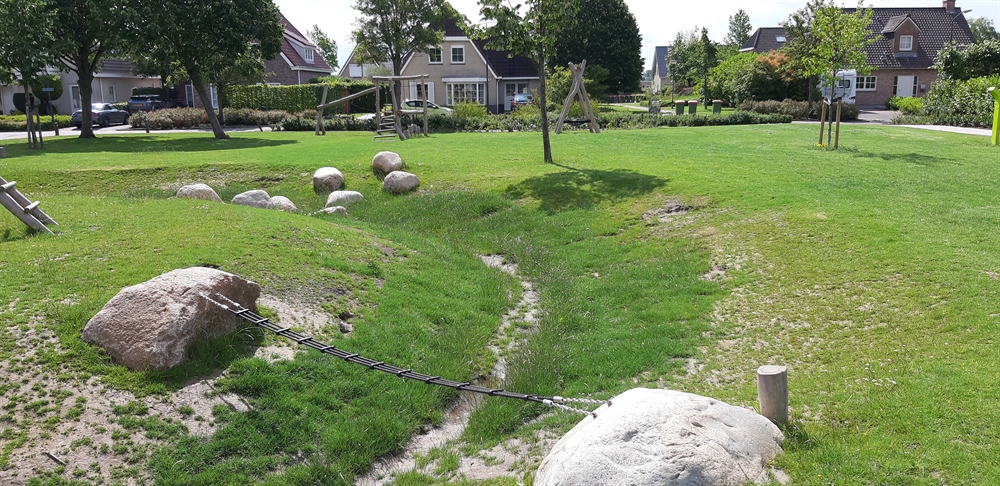Municipality of Moerdijk uses Zilvermeeuw play park to tackle waterlogging
The West-Brabant village of Fijnaart is vulnerable to extreme downpours. In order to tackle waterlogging, the municipality of Moerdijk has initiated the Fijnaart WaterProof project. Among other things, this project involves the construction of a new playground on Zilvermeeuw street. It has become a genuine play park, also featuring a wadi. The water collected by the wadi constitutes one of the play elements in the play park.

How has the Zilvermeeuw play park been developed?
With the Zilvermeeuw play park, the municipality of Moerdijk is interlinking two individual public space taskings: the Room to Play Plan and the Fijnaart WaterProof project. Under the Room to Play Plan, Moerdijk has been adapting and enhancing old playgrounds since 2017. Under the Fijnaart Waterproof project, it has been combating waterlogging since 2016, for example, by creating water storage facilities. By renovating an old playground and creating a wadi, the municipality is combining these two ambitions. The short film below gives you a virtual tour of the play park.
Who has been involved in the construction process?
A key element of the Room to Play Plan is the involvement of residents in new projects, as play areas also serve as meeting places for adults and the elderly. For that reason, local residents have been involved in the construction of the Zilvermeeuw play park. Several gatherings were held to enable them to present their needs. Subsequently, the municipality compiled a design sketch, to which residents could respond. The municipality conveyed the views submitted by the local residents to Boerplay contractors. Boerplay have incorporated the views into the eventual implementation plan.
How does the wadi in the play park work?
During severe downpours, water from the street can flow into the wadi. If the water level in the wadi rises too high, a drainage pipe will drain the water into the sewer. Concurrently, the wadi is one of the main play elements in the new play park. The wadi is constructed as a moat around a play island featuring a range of play equipment. If the wadi fills up with water, children can cross it via a fallen tree, large boulders or a wobbly bridge.
Play park filled with water fun
Adjacent to the play park lies a large pond. The municipality has connected the pond to the play park by removing two pollard willows. As a result, the two areas appear to belong together. Furthermore, a water playground has been created, featuring a hand pump to pump up water. Via a wooden trough, the water flows into a small reservoir. Water is thus the main theme of the play park. The municipality considers it important for the play park to radiate an image of water fun.
Conducive to social cohesion and biodiversity
The Zilvermeeuw play park is a place where people of all ages can meet. The park is thus also fostering social cohesion in the neighbourhood. In addition to playing with water, children can run around here, climb, play on the swings, and play with sand. For adults, the park features exercise equipment to keep fit. Furthermore, the municipality has decided against mowing the grass on some of the slopes, thus allowing biodiversity to grow.
Lessons to be learned
The future will tell how effective the Zilvermeeuw play park is in combating waterlogging. This is what the municipality has already learned during the construction of the wadi: during periods of heavy rain, the wadi must not remain filled to the brim for too long. This is dangerous for little children, who could drown in the water. For that reason, the bottom of the wadi is fitted with a pipe to drain water into the sewer. In hindsight, the municipality would have preferred to connect this pipe to the pond. This would have been even better in terms of relieving pressure on the sewer system.
Contact person
Bert Voeten
Bert.voeten@moerdijk.nl
